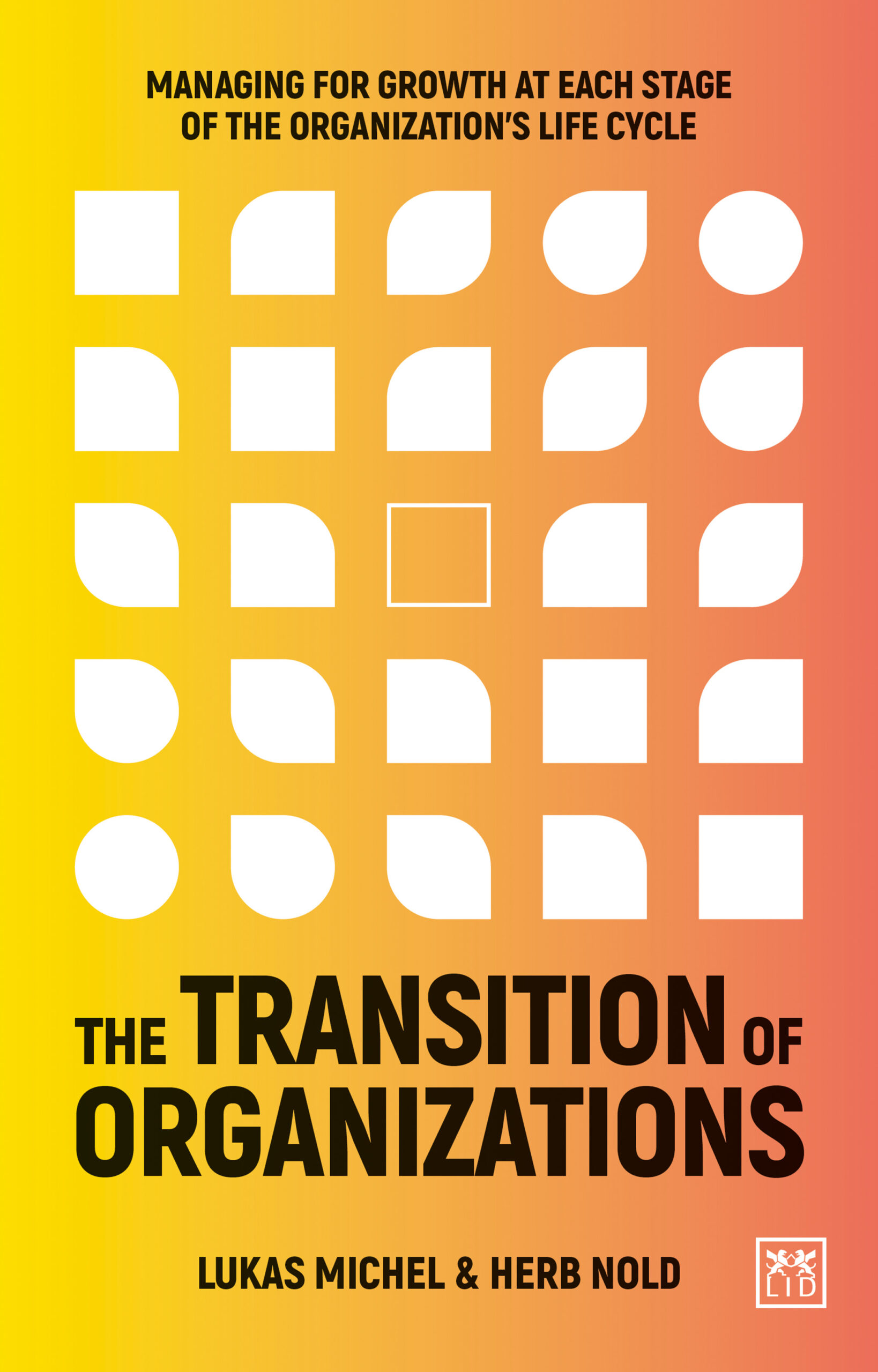|
Solving the Crisis of Autonomy with Lukas Michel & Herb Nold
Solving the Crisis of Autonomy

By Guest Contributors Lukas Michel & Herb Nold
Authors of The Transition of Organizations, Lukas Michel and Herb Nold, reveal how to overcome the crisis of autonomy once you move to the second stage of your organization lifecycle.
The Transition of Organizations is the result of 20 years of work with clients around the globe and the related research that enabled us to conclude that there are patterns of deliberate strategies companies can follow to overcome their inherent structural crises.
Organizational growth follows five life cycle stages: creativity, direction, delegation, coordination, and collaboration. Every stage comes with specific evolutionary and revolutionary attributes, followed by a crisis or organizational challenge that must be overcome to advance to the next stage. We evaluate organizations by looking at their structure through the lens of viewing management as a competitive advantage. Mapping management patterns using the Leadership Scorecard tool allows us to identify the dominant management style for each life cycle stage.
More on the GROWTH LIFE CYCLES
The direction stage. The second stage is ‘direction.’ In the direction stage, the organization has grown beyond the creative entrepreneurial stage. The founders have resolved the crisis of leadership and the organization has grown in size and complexity by establishing functional departments with specific expertise and scope of responsibility. Functional departments engage professional managers with specialized skills to operate essential parts of the value chain (R&D, production, distribution, marketing, finance, communications, HR) under directive leadership. Over time these managers compete for limited resources and recognition, and typically feel restricted by centralized directives that limit their actions and damage sensitive egos. The second crisis of autonomy emerges, which must be negotiated to continue advancing up the growth staircase. People-centric management solves the autonomy crisis and establishes delegation capabilities.
The functional organisation. As the pace of growth increases, new locations are added, more people are hired, and more markets are served. To reduce redundancy and increase efficiency, leaders introduce functional units populated with people possessing specific skills and managed by individuals with prior experience in the field. Product development, manufacturing and sales departments emerge, along with infrastructure units such as HR, accounting and finance that are created and managed as separate cost centres.
The new functional managers and their teams assume responsibility for setting direction within the department’s area of responsibility. Lower-level supervisors are treated as functional specialists, with a focus on implementation and directing the day-to-day activities of a staff.
Crisis of autonomy. Unfortunately, the success of driving functional efficiencies hampers the creativity and initiative that were the hallmarks of the original entrepreneurial business. With narrow job specialization and tight performance goals, employees find it difficult to respond to customer issues and internal interferences. Organizations lose vitality and their ability to quickly adapt to changing market conditions and opportunities is lost. Employees find it difficult to work across organizational boundaries as silos interfere with the free flow of knowledge. Central support functions find it hard to establish shared rules applicable to everyone, covering every eventuality, and to bridge the inherent barriers of the organization. Frustration builds, leading to a crisis of autonomy. The founders and senior leaders are blamed for the loss of the entrepreneurial spirit and widespread frustration as people struggle to feel engaged.
People-centric management. The second transition is the move from the direction stage to the delegation stage. Delegation helps overcome the crisis of autonomy, which emerges as the key barrier that restricts growth to the next level. The task at this point is to adapt people-centric management techniques, using the Leadership Scorecard as a guide, to delegate power and decision-making authority throughout decentralized units.
Solving the crisis of autonomy. Moving from a functional structure in the rules-based mode of operation to a decentralized company, where key decision-making authority is distributed throughout the organization, means adopting a people-centric, engagement-based management mode. People-centric management concepts are built around self-responsibility, teamwork, focus of attention and developing individual capabilities. This is how managers delegate responsibility and accountability, engage employees, coordinate work, mobilize the energy and enable change.
Management modes group general managerial styles into four categories, with different capabilities, depending on the context or general environment in which the organization operates. People-centric principles are the primary features of better management. People-centric techniques create an environment that offers knowledge workers the opportunity to be creative and perform at their best.
To solve the crisis of autonomy of functional managers, established in the direction phase, adopt better management techniques. These new techniques set people-centric management principles as the pre-condition for a decentralized organization with delegated responsibility. People-centric management differentiates from traditional management through a choice of four levers as the dominant management style.
Engaging people is the answer to operating successfully in decentralized organizations with distributed decision-making and responsibility needed to continue growing. In a knowledge-driven industry that is stable, with little change, the engagement-based mode dominates. People are tightly governed by traditional means, but with a people-centric management style that encourages creativity and teamwork. Rules and performance measures may apply to both individuals and teams.
People-centric management supports self-responsible employees in an environment that limits interferences and promotes focus of attention. People can focus their abilities on the issue or challenge of the moment, to come up with innovative solutions. Management aligns individual interests by promoting and instilling common visions, beliefs, boundaries, and values. As Harvard Business School’s Robert Simons (1995) put it, “In the absence of management action, self-interested behaviour at the expense of organizational goals is inevitable.” Self-responsibility and focus of attention are balanced with hierarchical power and institutional bureaucracy in the engagement-based mode of operation.
Building delegation capabilities. Management systems are the tools that allow professional managers to intervene when needed, to keep the organization on track. Systems provide essential information that is necessary to guide strategy, task implementation, shared beliefs, and authority boundaries. Integrated systems allow managers to keep an eye on operations from a distance, which permits front-line workers to apply their problem-solving skills and creativity within predetermined boundaries.
Delegation solves the crisis of autonomy, which emerges during the direction stage of growth. Effective transition from the direction state to the delegation state requires the application of people-centric and engagement-based management principles. Improved management systems solve the tension between people-centric capabilities and the need for control.
The company has grown in scope and complexity thanks to entrepreneurial success. Functional organizations are created with professional managers to oversee specific functions or divisions under directive leadership by senior executives. The second crisis of autonomy mounts as functional or divisional managers compete for resources and recognition while being controlled by the directives from the cadre of senior executives. Further growth comes from people-centric management with management systems that create better delegation capabilities.
What can you do?
- Delegate responsibility through the application of people-centric management techniques.
- Review your organization’s delegation capabilities.
- Assess the Leadership Scorecard questions with your team.
- Activate an engagement-based management mode.
- Manage decentralized organizations through five management systems.
Key words: Direction – the functional organisation – crisis of autonomy – people-centric management (solving the autonomy crisis), building delegation capabilities
————————————————————————————————————————————————
Bibliography: Greiner, L. E. (1998). Evolution and Revolution as Organizations Grow. Harvard Business Review: Mai-June.
ABOUT THE AUTHOR

Suggested Reading
 The Transition of Organizations explores various common patterns of management styles and then offers transition strategies to help managers succeed in the digital economy. The authors guide leaders to prepare for these transitions by laying the foundations or infrastructure needed to prevent a crisis that inhibits further growth. They also provide leaders with a greater understanding of the growth framework, which will help leaders to manage better the development of their companies.
The Transition of Organizations explores various common patterns of management styles and then offers transition strategies to help managers succeed in the digital economy. The authors guide leaders to prepare for these transitions by laying the foundations or infrastructure needed to prevent a crisis that inhibits further growth. They also provide leaders with a greater understanding of the growth framework, which will help leaders to manage better the development of their companies.

